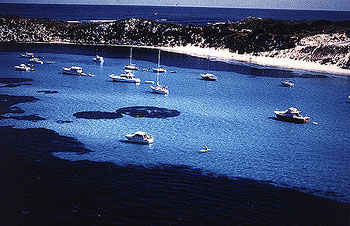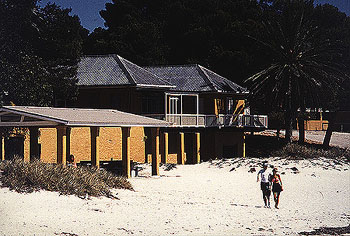

Tony Fogarty
copyright 20APRIL'93
It is absolutely unique. There isn't another anywhere in the world but right here in Western Australia.
To be geographically honest, it is not actually 'in' W.A., rather it floats in the Indian Ocean about nineteen kilometres north-west of Fremantle. It is Rottnest Island, and at only twelve kilometres long by five and a half kilometres wide, it is the only piece of dry land between Perth and Capetown.
It's prime purpose these days is as a get-away-from-it-all, without getting so far that you cannot get the morning paper the same morning it is printed. 'Rotto', is only forty-five minutes from Fremantle by the slow ferry, twenty-five minutes by the quickie, or fifteen minutes by air. My lady and I, found the slower boat trip is a lovely way to start your Rottnest experience, and it is cheaper.
We had decided to spend three nights on the island, mid-week to avoid the weekend rush, so we contacted the Rottnest Island Authority which manages Rotto to check out accommodation. And we had a wide choice. It is wise to consider what you actually plan on doing during your stay, and how tight your budget is, when choosing your accommodation. If you are a couch potato, and are there to simply 'veg-out' in front of your rented T.V., watching the Crows versus the Magpies, there is a large selection of villas or cottages with all mod-cons,( except telephones).
If, on the other hand you are going to get out and do a snorkel tour of the many shipwrecks around the island or circumnavigate Rotto by push-bike and listen to real crows and real magpies, all you need is a base-camp. As we tend toward the latter, we booked our esky into a Carol Thomson Family Cabin. Named after the wife of the first farmer on Rottnest, the cabins are sort of shot-gun marriage between a chalet and a tent. At one end of the cabin is an amenities block which includes a toilet, handbasin and a shower with heaps of hot, fresh water. As a lot of the more substantial dwellings have salt-water showers, this is a real bonus, particularly for an extended stay. The block is also lockable, providing an element of security for cameras or ghetto- blasters while you are down the beach. There is a kitchenette at one end of the permanent tent portion furnished with pots, a kettle and crockery for six. You are required to supply your own cutlery, and cooking tools. We would also recommend you bring a tea-towel, a dish-cloth and some detergent.
Finally, the main living area has a dining table that may be screened off from the sleeping area which has two bunk beds, and two single beds. If your party is greater than two, opportunities for amour` may need to be negotiated!
The first Europeans to spend a long weekend at Rotto were a Dutch group led by Captain Samuel Volkersen. That was in 1658. Nearly forty years later, in 1696, Willem de Vlamingh did a hiking tour of the island. Vlamingh chose to sleep on his boat by night and enjoy Rotto's delights by day. Many people still do. In fact the waiting list for private moorings is so long that a place on the list may be bequeathed. Vlamingh also named the island, 'Island of Mist', in his reports. These reports also frequently referred to large 'bush rats' encountered by his crew. During later transcripts, a Dutch clerk renamed the island 'Rottnest', which is Dutch for 'rat's nest', in recognition of these bush rats or quokkas. These cute little wallabies abound right across the island and as they are no longer hunted, they venture into the settlements at night. Hand feeding is tolerated though it is not encouraged.
The French and English visited Rottnest after the Dutch but it wasn't until 1829 when the Swan River Colony was founded that a permanent presence was established. For the next ninety years the island was variously used for growing salt (Carol Thomson's husband), imprisoning Aborigines and reforming naughty boys until 1917 when it was declared an A-Class public reserve.
The island is managed by the W.A. Government through the Rottnest Island Authority. When we arrived at Rotto, the first thing we did was call into the Authority's Visitor Centre which is located at the end of the jetty. It is full of information on what to see, where it is and how to get there. There are plenty of freebies by way of brochures and maps.
By far the most popular mode of transport is by push-bike. If you have your own, you can bring it across with you on any of the ferries. If you do not, you can hire a mountain bike on the island. The price is structured so the longer you stay, the cheaper it is.
After parking our esky, grabbing a fist full of brochures and maps, and hiring our push-bikes, my lady and I sat for a cuppa to plan our next couple of days. We were decidedly flexible as we had chosen to leave our watches at home which meant time was not a major consideration. If we really needed to be somewhere at a given time, we could always ask another pioneer.
We chose several 'must do's', a couple of 'might do's' and discarded a few 'leave it till next time's'. The 'must do's' were push-biking it to Geordie Bay, the museum, a round of mini golf and lots a lazing down the beach at The Basin, which was a short ride from the cabin. The 'might do's' were an aerial joy ride around the island, a bus trip to Cape Vlamingh and a game of tennis. Snorkelling and diving gear were available for hire, but we left them for next time.
We ended up doing the bus trip to the west end which included a visit to the Oliver Hill gun battery. Though the 9.2 inch canon was established during the Second World War to protect Fremantle from tourists it has never fired a shot in anger. Oliver Hill meanwhile, is one of the highest points on the island and the view on a sunny day with the sea breeze at your back is spectacular.
The highlight of the bus trip was Fish Hook Bay, which is only accessible by descending down a cliff face. Not one for the faint hearted. The reward was an exhilarating swim in an ice cold, crystal clear lagoon that gave new meaning to the word goose-bumps.
Meals were very informal whilst on Rotto. We had a couple of meals at our cabin, and we also patronised some of the island eating houses. The restaurants ranged from fish and chips to a fully licensed, a la carte cuisine.
Rottnest even has a mall, of sorts. There is a fully operational bakery, the General Store, a BBQ chicken take-away, a hairdresser and a 'fashion' boutique.
We spent four relaxing days on Rottnest Island, walking, riding all in our own time. We weren't completely out of touch, just enough to switch off and unwind. For couples or families we would rate the island as 'highly recommended', and worth another visit.

Didn't we say Rottnest Island was unique? It is, in a quaint sort of way. From 5,000 feet, it is the only island in the world shaped like it's most profuse inhabitant, in this case, the Rottnest Island Quokka.